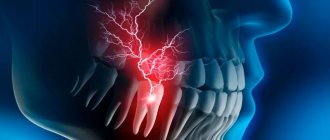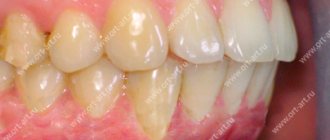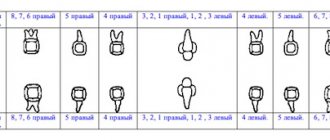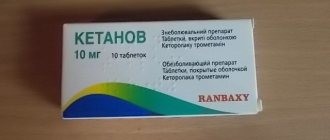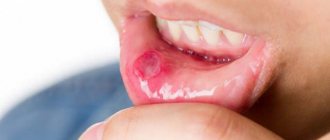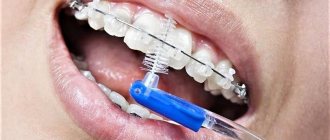Pulpitis is an inflammation of the internal structure of the tooth - the neurovascular bundle. In the vast majority of cases, this disease is caused by caries - many parents believe that it is not necessary to treat it, because baby teeth must be replaced quickly. However, this statement is incorrect, since caries, which is not addressed in time, causes tooth destruction and inflammation of the pulp.
Primary molars, especially the lower ones, are more susceptible to this. This is due to the relatively thinner enamel - the infectious process reaches the internal structures of the tooth faster. For the same reason, pulpitis in children develops much faster than in adults.
Among the causes of the disease are also injuries, including those associated with improper treatment of enamel caries, when the doctor accidentally exposes the pulp during tooth preparation.
Symptoms of pulpitis in children
Symptoms and treatment of pulpitis in children vary depending on the form and severity of the disease. Pulpitis has two forms - acute and chronic. The first is relatively less common, but the symptoms in this case are more pronounced. There are two stages of the inflammatory process:
- Serous. The pulp becomes inflamed, and the tooth canals are filled with serous fluid. The child experiences severe pain in the tooth, which intensifies at night or with exertion—chewing on the side of the causative tooth. Often there is only one episode of pain. Within a few hours, the inflammation moves into the next stage.
- Purulent. Purulent contents begin to form in the root canals of the tooth. The severity of this stage depends on several parameters: the state of the child’s immune system, the activity of microorganisms, the state of the root system of the tooth, and the age of the young patient. The pain can be tolerable if the child’s immunity functions normally, microorganisms multiply slowly, and pus escapes through the carious cavity of the tooth. However, more often there is quite pronounced pain, prolonged attacks, and the unpleasant sensations radiate to other teeth. They intensify with mechanical, temperature effects on the causative tooth; the child’s appetite worsens or he refuses food altogether. In rare cases, there is an increase in body temperature and enlarged lymph nodes.
It is worth noting that chronic pulpitis can be asymptomatic, and there are often cases of the development of an inflammatory process in a previously filled tooth. The fact is that it can be quite difficult to properly treat the carious cavity of a child’s tooth before filling it - this is due to the emotional state of the patient and the forced haste of the dentist. This leads to the fact that the filling is installed in a cavity that is not sterile or is not sufficiently dried from saliva - pathogenic microorganisms continue to multiply, penetrating deep into the tooth and causing pulpitis.
With chronic pulpitis, pain can only occur when food debris gets into the carious cavity. The gangrenous form of the disease is characterized by the appearance of pain some time after eating hot food, a feeling of fullness and heaviness in the tooth, and bad breath.
Etiology of pulpitis
Based on etiology, which implies the nature of the inflammatory process, pulpitis is divided into three types. The classification is carried out depending on the nature of the irritant acting on the pulp:
- Infectious pulpitis develops in acute, but more often chronic diseases of the teeth and oral cavity (caries, osteomyelitis, periodontitis, etc.). In rare cases, the infection enters the root canal and pulp through the circulatory system from other units of the jaw or internal organs.
- Traumatic pulpitis develops when a tooth is damaged with the opening of a traumatic cavity (crack, chip) into the pulp. Occurs with sports injuries, crown and root fractures.
- Iatrogenic, that is, occurring after dental treatment . Occurs after treatment of deep caries, when the internal tissues of the teeth are irritated by the use of chemical, mechanical or thermal irritants.
Knowledge of the etiology helps the dentist select the most appropriate treatment methods and avoid complications in the future.
When should you visit a dentist?
The sensitivity of the neurovascular bundle of a tooth in a child is lower than in an adult, so the symptoms of its inflammation may be erased or absent altogether. It is important to contact a pediatric dentist when the first symptoms of caries appear - a dark spot on the tooth, or the child complains of pain. You should hurry up with your visit if:
- severe pain;
- increased pain when eating hot or cold food/drinks;
- bad breath;
- elevated body temperature;
- inflammation of the gums around the tooth;
- darkening of the enamel.
Symptoms
Inflammation of the pulp is not difficult to differentiate already at the stage of examining the oral cavity and interviewing the patient. This disease is characterized by:
- sudden onset of pain and its intensification at night;
- a gradual increase in pain intensity and duration in the first 3-5 days from the onset of the disease;
- irradiation (spread) of pain to the ear, eye, chin, depending on the location of the diseased tooth.
A characteristic feature of pulpitis, which makes it possible to distinguish it from caries and other dental pathologies, is a sporadic increase in pain, which is not associated with thermal, mechanical or other effects on the tooth.
Pulpitis of a baby tooth: is it necessary to treat?
Treatment of pulpitis in children should be carried out in any case and as soon as possible. It is unacceptable to wait for a baby tooth to fall out, stopping only the symptoms. Failure to provide assistance to a child can result in serious complications - periostitis (in common parlance - gumboil), periodontitis - inflammation of the periodontal tissues. In addition, the infectious process in the neurovascular bundle of a baby tooth can spread to a permanent tooth when it erupts.
If a long time must pass before the eruption of a permanent tooth, premature destruction of a baby tooth due to pulpitis can lead to malocclusion - displacement of healthy teeth in a row, change in their position, which will require complex orthodontic treatment in the future.
If a baby tooth with pulpitis is soon to be replaced by a permanent one, the doctor may resort to extraction. In any case, this disease should not be ignored.
Treatment methods for pulpitis
The tactics of a pediatric dentist depend on the condition of the child’s tooth and dental system, the severity of his condition, and whether there are concomitant diseases of the oral cavity. If the pulpitis is very severe and there is a risk of a threat to its health, the tooth must be removed. However, in the vast majority of cases, it is possible to keep the tooth permanent until its natural replacement, since removal can lead to disruption of the bite or the position of the remaining healthy teeth in the row.
Traditional treatment of dental pulpitis in a child consists of devital amputation of the pulp and is carried out in several visits. The stages of treatment of pulpitis in children are presented as follows:
- The doctor opens the tooth cavity, removes carious tissue, and applies a paste to devitalize the pulp. It is designed to “kill” the neurovascular bundle and eliminate pain. If the paste contains arsenic, it is used for a period of 1-2 days; if an arsenic-free product is used, it is used for at least 7 days.v
- The second visit involves placing a special mixture into the canals for tissue mummification - a resorcinol-formalin mixture is used.
- The third visit is to fill the diseased tooth.
This method is practiced much less frequently today, since there is a possibility that the infectious process will persist in unsealed tooth canals - mummification of the pulp involves its “drying out” and the formation of voids in which pathogenic bacteria continue to multiply.
The modern approach to the treatment of pulpitis of primary teeth in children is extirpation - complete removal of the inflamed pulp. This can be done with or without prior killing or devitalization of the pulp. In many cases, devitalization is more preferable, since it relieves the child of any unpleasant sensations during the removal of the neurovascular bundle.
After the tooth canals are freed from pulp and carefully processed, the doctor fills them with an anti-inflammatory paste - it tends to dissolve along with the roots during the natural change of teeth to permanent ones. For this purpose, zinc eugenol paste is often used. This method of treatment is comparatively more effective, and if the canals are treated with the utmost care, the infection will not reactivate. Other modern methods of treating pulpitis in children include vital amputation. It consists of preserving the viability of part of the pulp - the upper part of the nerve is removed under local anesthesia, and a medicine with an antibacterial and anti-inflammatory effect is applied to the remaining root pulp. The drug closes the lower part of the neurovascular bundle without affecting its viability, and the tooth is subsequently filled.
Indications for the use of a biological method of treating pulpitis
Typically, the indications for the use of a biological method of treating pulpitis is the presence of sufficiently deep caries in the cavity in the absence of pain: in this case, it becomes a preventive measure to prevent the aggravation of the situation.
Its use is also possible for acute pulpitis, but only in the first hours after the onset of pain. It can also be recommended when, during the treatment of a caries cavity with a bur, an accidental opening of the pulp occurs.
In all these cases, the inflammatory process is either absent or at the very beginning. If the moment is missed, and the pulping has gone far enough, removal of the pulp, alas, is inevitable.
Similar articles
- Dentistry metro station Dmitry Donskoy Boulevard
- Treatment of pulpitis in Northern Butovo
- Treatment of dental cyst
- Air Flow teeth cleaning
- Gum treatment
Treatment of pulpitis of teeth with unformed roots
The root system of a baby tooth is formed over a long period of time after eruption, so there are often situations when caries begins to form on a tooth whose roots have not yet closed the apex. This leads to some treatment difficulties:
- short roots and wide channels;
- the upper part of the root is the “growth” zone, injury to which is an obstacle to root formation;
- the likelihood of infection of the permanent tooth germ;
Treatment of pulpitis of teeth with immature roots in children requires special care. The doctor must carefully monitor that the filling material is not carried beyond the expansion of the root apex. It is worth noting that complete removal of the pulp and treatment of the canals is impossible - the optimal solution here is vital and devital extirpation. Pulp amputation may also be used. The biological method, which consists in preserving a viable pulp and relieving inflammation, is also practiced quite often. Its essence is to prepare the tooth, apply a medicinal paste with calcium hydroxide, after which the tooth is filled with temporary material. A few days later, if there are no complications and the unpleasant symptoms disappear, the doctor installs a permanent filling.
Unique and irreplaceable: ease of use and high biocompatibility
Every dentist in his practice had to deal with such clinical situations as: treatment of perforations, defects resulting from root resorption, filling the apical part of the canal, closing the apex of an immature root.
The problem arises of choosing a material that adequately meets all the requirements and conditions of use. The appearance of ProRoot cement on the dental market literally created a revolution.
“ProRoot” (Mineral Trioxide Aggregate, MTA) was developed at Loma Linda University (USA, holder of a development patent in 2002 by Professor of the Department of Endodontics M. Torabinejad).
Studies of the material have revealed its compliance with the requirements for an ideal material: biological compatibility, reliable sealing, absence of inflammation in surrounding tissues, odontotropic action, regeneration of pulp, dentin, cement, bone, the only material on the surface of which cementogenesis occurs, high tolerance to moisture, high radiopacity, final curing time – 4 hours
There is an opportunity to extend the life of natural teeth. For example, in case of root perforation, regardless of how long ago it occurred, reduce the time of treatment of teeth with unformed apex using the apexification method.
To date, the material has been time-tested and we can talk about positive long-term results. MTA showed better sealing abilities compared to other materials.
Clinically, MTA has been used in the following procedures:
- vital pulp covering,
- apexification,
- closing root perforation,
- retrograde filling and restoration of root resorptions.
Biological method of treating pulpitis
There are many approaches to the procedure of direct capping of the pulp chamber, which consist of both direct capping whenever the pulp chamber is damaged, and the use of endodontic treatment when it is damaged.
The main selection criteria for the biological method of treating pulpitis are:
- accidental opening of the pulp during mechanical treatment of a carious cavity during the treatment of caries;
- phenomena of incipient pulpitis or pulp hyperemia in the absence of complaints of pain from temperature and chemical stimuli of a prolonged nature (more than 2-3 minutes);
- no complaints of spontaneous pain during the day or night at present or in history;
- no discomfort when biting on a tooth;
- absence of radiologically detectable changes in periapical tissues;
- an objective examination of the oral cavity excludes pathology of the oral mucosa, generalized periodontitis of moderate and severe severity, and a periodontal pocket in the tooth area;
- the patient's age is not older than 45 years;
- low caries intensity and good oral hygiene.
Some physicians advocate the use of endodontic treatment for any perforated carious pulp cavity, regardless of its size or symptoms. However, clinical experience has shown that some carious lesions can be successfully treated with direct capping of the pulp chamber. The key to success is making the correct diagnosis. Covering the pulp chamber is a surgical intervention that aims to preserve the vitality of the tooth and stimulate the formation of tertiary dentin in it.
Many doctors, out of frustration or ignorance, resort to using old techniques instead of using the latest research and materials that may be a better alternative for their patients.
The costs associated with conservative pulp capping, as opposed to endodontic treatment, are less expensive, require less time to complete, and are more acceptable to the patient.
There are two options for partial necrectomy of carious tissues. The first, most commonly used by physicians today, is a one-step approach that is completed in one patient visit but has a higher failure rate. There are studies by the authors that make it possible to leave areas of carious dentin using a one-step technique. The option of leaving a layer of carious dentin and applying a protective dressing to deliberately prevent perforation of the pulp chamber is known as indirect pulp capping. The second option, which is more effective, consists of two stages, which include the installation of a temporary filling during the first visit after partial removal of carious dentin. During the re-appointment, sometimes a few months later, the procedure is completed with the installation of a permanent filling.
The layer of damaged dentin can be as thin as 1 mm, making it difficult to distinguish one type of dentin from another. Some doctors and researchers suggest using a caries indicator solution, the chemical structure of which binds to the denatured collagen of pathological dentin. However, the clinician must work with extreme caution so as not to damage the pulp chamber during necrectomy of pathological peripulpal dentin.
Over the past 10 years, a large number of materials and preparations for direct and indirect pulp capping have been introduced. In a recent report of a clinical trial conducted by INIS Hilton in collaboration with others in 2013, the likelihood of a favorable outcome of direct pulp capping of permanent teeth with MTA (Mineral Trioxide Aggregate) and CaOH (calcium hydroxide) was assessed and compared with a significantly higher likelihood unsuccessful treatment of the latter.
MTA-based materials used as a base liner on damaged dentin used in the process of direct pulp capping have demonstrated their suitability and are therefore recommended for use
Adhesives have been researched and used for some time as pulp capping materials. Their use would save time and costs, but, unfortunately, they are toxic to pulp cells, which reduces regeneration and leads to chronic inflammation.
During direct pulp capping, disinfect the cavity and control bleeding with 2% chlorhexidine, sterile saline, or sodium hypochlorite. Use MTA in conjunction with a glass ionomer base gasket to ensure good sealing of the restoration under rubber dam insulation conditions. By the way, rubberdam is the English term for damper, and rubberdam is German. This is the difference.
On the second visit (after 7-10 days), monitor the electrical excitability of the pulp and, in the absence of negative dynamics, complete the tooth restoration using photocomposite. Repeat the control examination after 1, 3, 6, 12 and 24 months with mandatory EDI and targeted radiographs.
- Apical foramen rupture
- Longitudinal perforation of the root canal wall
- Apical perforation of the root canal wall
Apexogenesis
Treatment based on preserving pulp vitality is the treatment of choice in immature teeth (incomplete apex development). Apexification is recognized as one of the most common techniques for achieving these goals.
Apexogenesis is defined as therapy on the vital pulp of immature teeth that allows continued root formation and apical closure.
Permanent immature teeth in children respond positively to directed apexogenesis. This rule remains true in carious teeth and in teeth after injury, but only with prompt and thorough treatment. The goal in such cases is to treat the pulp before it becomes necrotic. After necrotization occurs, therapy becomes more difficult for the doctor. If the pulp remains vital and the apexes are open, then the apexogenesis procedure is preferable to endodontic treatment.
Apexification
To stimulate the formation of an apical barrier from hard tissues in permanent teeth with immature root apices and necrotic pulp
Perforation of the root and bifurcation area
The prerequisites for the occurrence of perforations of the bottom and walls of the tooth cavity are:
- displacement of the tooth axis in the lingual or buccal direction;
- reduction in the height of the tooth crown due to significant abrasion of the chewing surface or deposition of a large amount of replacement dentin;
- endodontic treatment of a tooth through an artificial crown.
For example, when trepanning an incisor or canine, perforation of the wall of the tooth cavity at the level of the neck occurs as a result of preparation without taking into account the position of the tooth.
Clinically, perforations of the bottom or walls of the tooth manifest themselves in the form of a characteristic “sinking” of the instrument, bleeding and sharp pain in the patient in the case of treatment without anesthesia. Touching the site of a fresh perforation with a probe also causes acute pain. It is important to note that for a more accurate diagnosis of perforation, an apex locator should be used and an x-ray obtained.
When treating perforations of the floor of a tooth cavity, the most important factors are the location of the perforation and the time elapsed from its formation to closure. The best prognosis is observed in cases where the perforation is closed immediately, which minimizes trauma and infection of surrounding tissues. The most unfavorable localization of perforation is in the area of root furcation. Almost any perforation in this area leads to periodontal destruction.
In addition, the size of the perforation is an important factor. Treatment of teeth with root perforations is the least predictable. Sometimes it is possible to preserve a tooth as a necessary element of the dentition only for a while, and then it has to be removed. Therefore, it is important to prevent the occurrence of perforations.
The dentist must warn the patient about possible complications. These include: perforation of the bottom of the tooth cavity or root canal. In the event of tooth perforation or diagnosing perforation complicated by chronic periodontitis, the doctor must inform the patient about all available treatment methods.
released material for eliminating root canal defects “MTA Channel”
Indications:
- retrograde filling of the tooth apex;
- elimination of root perforations;
- elimination of perforations of the bottom of the tooth cavity;
- apexification;
- elimination of internal and external root resorption;
- filling the apical part of the canal;
- therapeutic insulating pulp coating
Some tips for using the MTA Channel material:
Careful mixing will make the material more flexible to use.
Mix the material with the liquid for approximately 1 minute to ensure that all powder particles are moistened
You can add 1-2 drops to mix the material to a creamy or “wet sand” consistency. Too little or too much liquid can reduce the strength of the cured material.
In case you need more working time, cover the mixed material with damp gauze to prevent evaporation.
My practical advice:
Using a thin cutter, make a recess in a plastic mixing plate to the length of the root canal and the depth you need - it is convenient to mix the material in this groove and insert the resulting “sausage” into the canal using a probe or plugger. You can condense with a sterile damp cotton ball.
“MTA Channel” is identical to the American material “ProRoot”, but costs 10 times less, this is worth paying attention to.
Good luck in life and work, dear Colleagues!
How to prepare a child for treatment?
Treatment of pulpitis of primary teeth in children is a rather complex task, so it’s great if the child is already familiar with the dentist’s chair. The first visit should be preventative - to familiarize yourself with the office environment, the doctor, and the instruments.
Also, the task of parents is to psychologically prepare the child. Required:
- talk to your child about doctors in a positive way - tell them that the dentist treats teeth and makes sure they don’t hurt;
- play dentist with toys and other family members;
- avoid mentioning pain or unclear, scary terms;
- do not deceive the child - explain that dental treatment may not be very pleasant, but it will not last long and the tooth will no longer hurt;
- remain calm, act gently but confidently if the child resists treatment;
- choose a suitable time for visiting - it is better in the morning, when the baby is alert and active;
- take a toy with you to calm the child;
- give the doctor the opportunity to establish contact with the small patient - do not rush him;
- Do not scare the child under any circumstances, do not threaten, do not blackmail.
If the situation cannot be controlled completely, you will have to reschedule the appointment for another day. However, the disease should not be ignored - treatment of pulpitis of baby teeth in children must be carried out one way or another. In special cases, treatment under general anesthesia may be considered, but this should be discussed with your doctor.
Possible complications of treatment of pulpitis in children
Child anxiety is the main difficulty faced by pediatric dentists. Due to the emotional state of the patient, the specialist has to rush or fails to perform the manipulation carefully, which may result in the following complications:
- the paste is not applied to the nerve - this leads to the fact that the pain does not subside, and the procedure must be repeated again;
- burn of the gums by the paste due to its close location to the tooth;
- bleeding when processing unformed roots;
- perforation of the root of a baby tooth;
- breakage of instruments in the root canal.
You can avoid possible complications or minimize the likelihood of problems arising by normalizing the child’s psychological state and contacting an experienced, qualified doctor.
Prevention of pulpitis in children
Treatment of pulpitis in permanent teeth in children, as well as their “predecessors” - baby teeth - is a rather complex procedure that may require several visits to the doctor. Preventing a disease is easier than treating it - all you need to do is pay attention to hygiene procedures and teach your child how to brush their teeth correctly from a very early age.
It is also important to monitor the child’s diet - strengthen the enamel with solid foods (carrots, apples, etc.), provide a balanced diet to saturate bone tissue with minerals. It is better to limit sweets and give only water at night. Prevention of caries is the basis for preventing its complications, including pulpitis.
